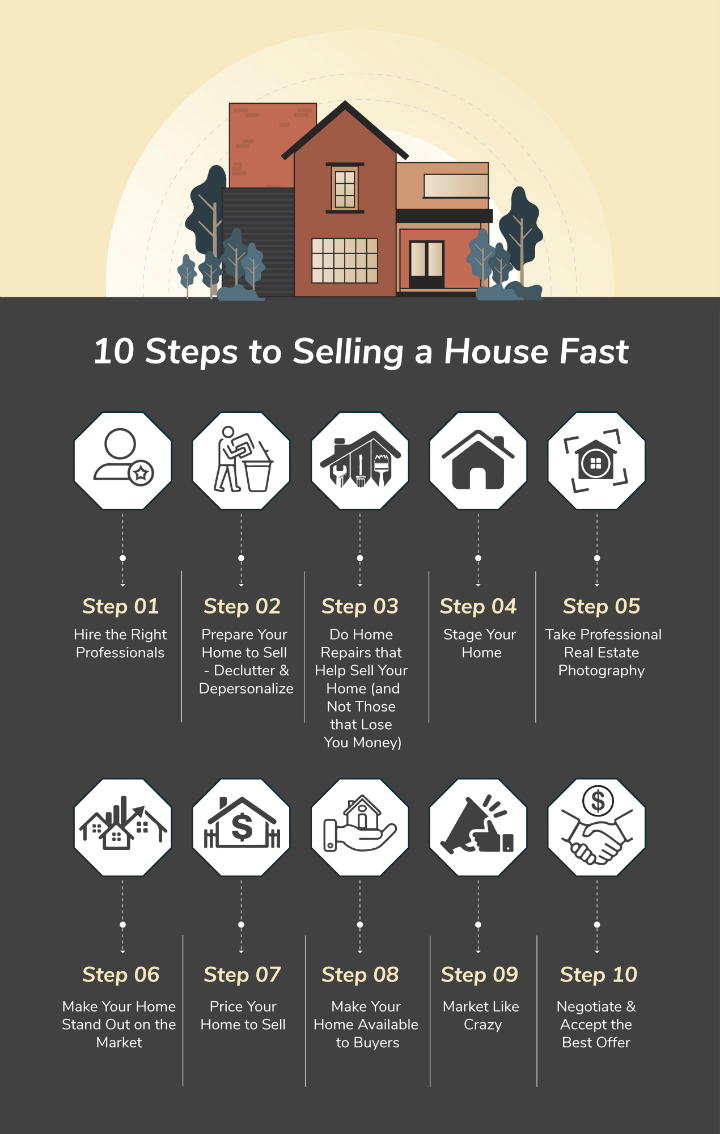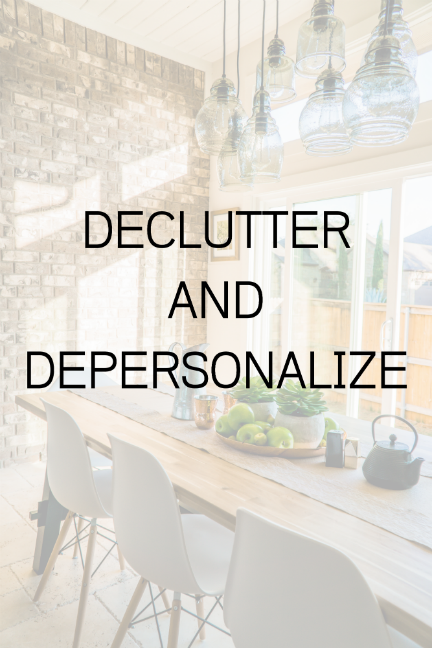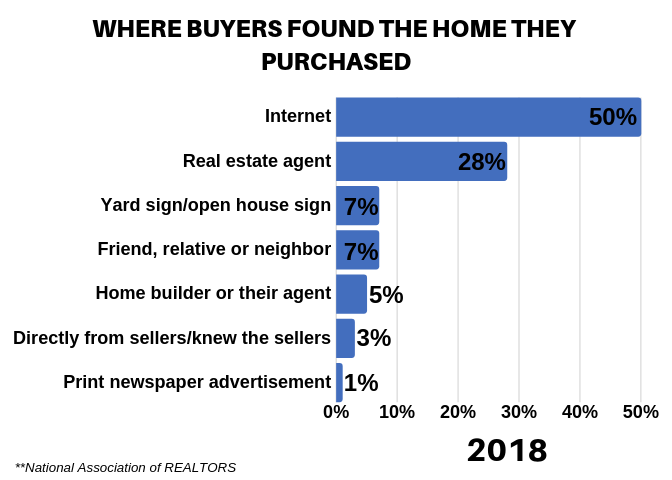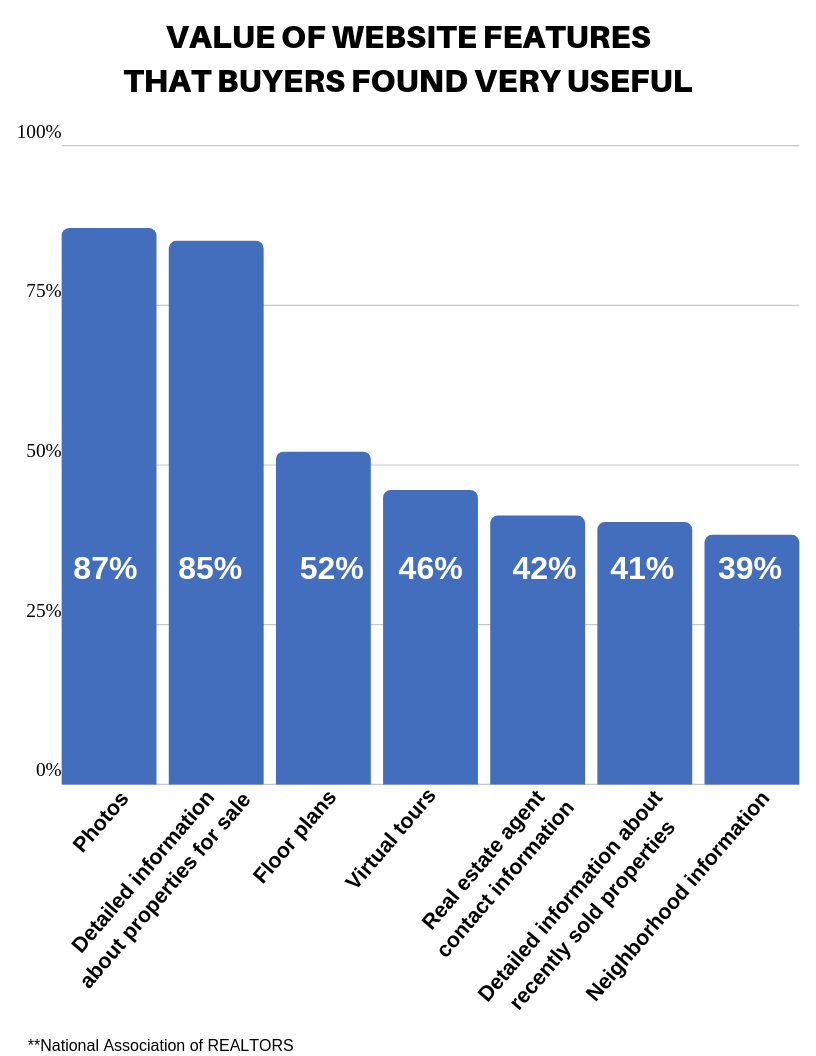The Ultimate Guide to Selling A House Fast (And How To Get The Most Money For It!)
How to Sell a Home in Houston
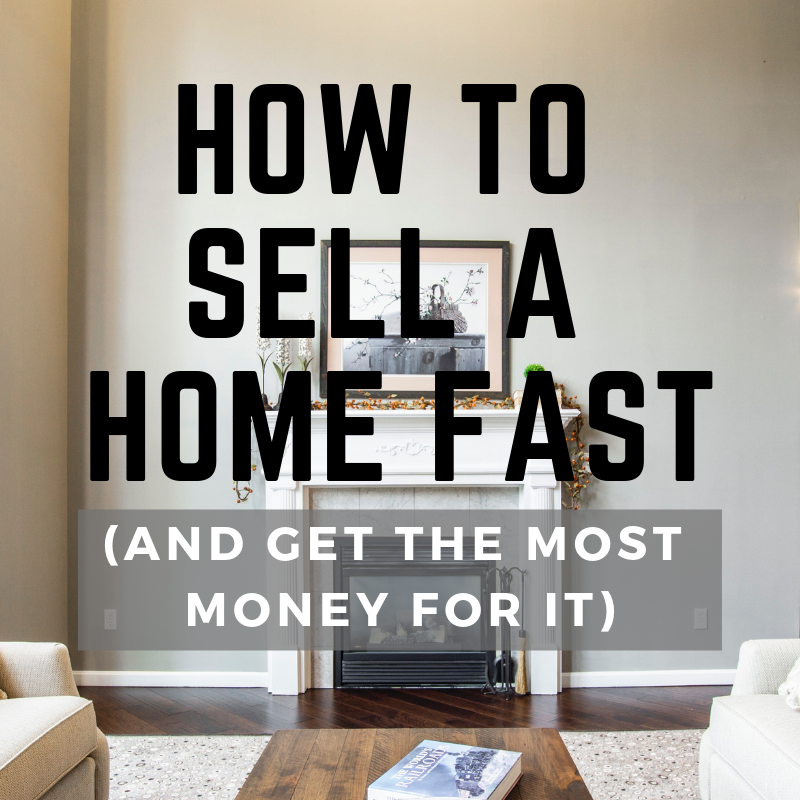
When you need to sell your house, you almost need to do it yesterday. Depending upon your market, it can often take anywhere from 60 to 180 days to sell a home (unfortunately some require more).
So, how is it that some homes sell quickly, and other homes sit around forever?
Most homes sell fast because they are priced at market value, in ‘move-in-ready’ condition, and in a great location. Houses that are not in a great location or that need repair, can sell quickly by lowing the price to determine what a willing buyer will pay. Any home can sell quickly with the right preparation, marketing and pricing. The trick is to walk the fine line of a fast sale and selling it for top price.
This article provides you the 10 step process to selling your home fast and putting the most money in your pocket. Any owner or agent can drop the price below its market value to sell it quickly, but most homeowners have more cash in their home than they realize. Many neglect to do the important work prior to listing their home and they miss out on fully maximizing their equity.
My name is Paul Holub and I’m a local Houston area Realtor®, and I know from experience how many homes sit on the market for too long because they don’t do these 10 Steps.
Who This Guide is For?
This is the perfect guide if you are selling your first home or tenth home.
It is for the homeowner who wants to sell fast, but wants to put the most cash in their pocket at closing rather than having to sell fast to an investor for less.
Why Would You Want to Sell Your House Fast?
I mean, who wouldn’t want to? The faster you sell your home the less time you need to spend keeping it clean and accommodating buyer tours. Plus, homes that sell faster, sell for only 1% less on average. Homes sold after two months on the market sell for an average of 5% less, and homes on the market for 11 months or more sell for 12% less than their list price. So, fast is the best way.
To make this happen, you as the homeowner must be willing to do the hard work up front, so your house doesn’t sit on the market long.
This post is extensive, but if you’d like to go into further detail about how to sell your home fast, check out my book The Real Estate Game Plan – The Step By Step Strategy to Sell Your Home for Max Profit. You can buy the paperback or sign up to receive a free ebook copy, today!
10 Steps to Selling a Home in Houston
Step 2: Prepare Your Home to Sell – Declutter & Depersonalize
Step 3: Do Home Repairs that Help Sell Your Home (and Not Those that Lose You Money)
Step 4: Stage Your Home
Step 5: Take Professional Real Estate Photography
Step 6: Make Your Home Stand Out on the Market
Step 7: Price Your Home to Sell
Step 8: Make Your Home Available to Buyers
Step 9: Market Like Crazy
Step 10: Negotiate & Accept the Best Offer
Step 1: Hire the Right Professionals
Okay, it makes sense that a real estate agent (yes, guilty as charged) would recommend hiring the right professional. It may sound a bit self-serving, but this article is coming from a place of contribution, and as one who has been in the industry since 2012, I know there are many agents you don’t want representing you as hiring the right agent can put thousands of extra dollars in your pocket.
Professional Realtor®
Our Team Left to Right: Natalie Painter, Paul Holub (yours truly) & Ruben Rodriguez
The first professional you look for is your real estate agent (I prefer this term over Realtor® because it’s fun for people to say “my agent said…”). There are many ways to find a great real estate agent and this article reviews the top 7 tips to hiring a great Houston Realtor.
Unless you have been given a great referral to an agent, or you have a good friend who is a real estate professional and you are okay doing business together (not all friends prefer to do business together), then I would recommend you interview 3 professional agents (13 Questions to Use When Interviewing a Realtor).
Your agent will make or break your time selling your home, so make sure you find the right one.
Professional Stager/Designer
If your real estate agent doesn’t provide a complimentary staging consultation, then you need to go out and find a stager to help you get the home ready. I prefer to hire a professional stager for all my clients occupying their house because I know that it will help their home sell faster and for more money.
The stager usually takes three hours for a professional consultation and inspects each room with the clients. They help to pack up items, move furniture, give suggestions on updates & repairs, and great home design advice. If your agent doesn’t provide these services in your agreement, then I’d recommend hiring a stager on your own as they are very affordable and can provide a great ROI (Return On Investment).
If you need a great home stager in Houston, check out this great post on the top 23 Houston home stagers and the biggest mistakes homeowners make when preparing their home for sale.
I would suggest having the stager come by prior to doing any repairs on your home so they can give you suggestions on paint and design choices. The purpose for selecting these professionals early is to prevent you from over-spending on updates that won’t generate a ROI.
Oftentimes, I tell clients that they shouldn’t spend any more money on their home, other than staging it with their own furniture. This is due to their home being in too much of a disarray or fully updated for the neighborhood.
General Contractor or Handyman
If you are not very handy like me, then you may already know a few good contractors. If not, ask your agent and your stager for some recommendations. If you are in the Houston area, here are some that myself and my clients have had positive experiences.
Your agent and your stager will give you direction as to what updates and repairs they would suggest completing. It’s your job to make sure your contractor does a professional job.
There is nothing worse than walking into a house that has been “updated,” but the work was completed by the homeowner or a terrible contractor, and it looks and feels like poor quality work. The texture repair sticks out, the paint is spotty, some blue tape is still left on the ceiling edge, the new flooring is squishy, and the trim isn’t straight.
I could go on, but you get the picture.
Cost
You are probably thinking that this is going to cost you a ton of money and for most homeowners, usually a couple hundred dollars can really impact the value and the speed to which your home sells.
It is the little things that will make the biggest difference.
For larger projects, you will have to decide with your professionals if it is worth the trouble and expense. If you spent $10,000 but had the potential to receive and extra $40,000 for your home, is it worth it to you?
How is this Faster?
How is taking time to interview and hire the right professionals “fast?” Great question! Getting the wrong advice can have your home sitting on the market for an extended time with little buyer activity and no offers.
You can always just list your home on the market “as is” or sell it to an investor for a steep discount, but I’m advocating doing the hard work prior to listing so that your house sells quickly and for top dollar.
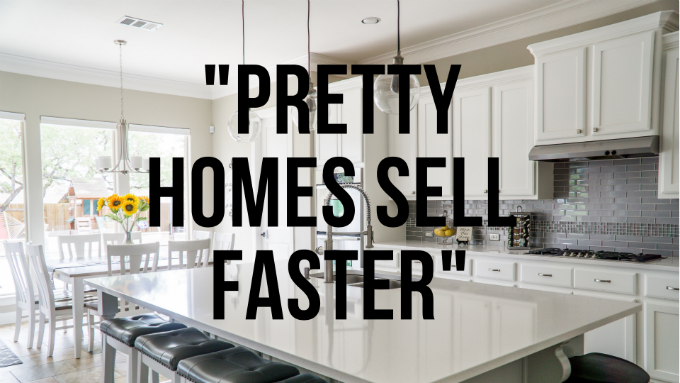
Pretty and move-in-ready homes sell faster and for more money because the majority of buyers just want to move into their new home and not hassle with major updates.
Now that you have the professionals in your corner, your next major task is to begin to get your house ready for the market.
Receive an Instant Home Value Analysis for Your Home
Step 2: Prepare Your Home to Sell – Declutter & Depersonalize
The real estate market is a competition and to make sure you win, your home needs to stand out for all the right reasons. If it does, it will attract a top paying buyer fast.
Far too often a home stands out for all the wrong reasons: funky layout, weird smell, dated design, thousands of dead bees on the counter and in the walls (true story) and it makes buyers pass for more beautiful homes.
It’s no mistake, pretty homes sell faster.
And the best way to make sure you stand out for all the right reasons is to get rid of all your junk and your very personal home design tastes.
That is why it is incredibly important to declutter and depersonalizing. Not only that, it can be used as “pre-packing” for your move. 😊
Declutter
The best way to start the process of getting your home ready to sell is to declutter your home. That means you need to remove your junk (I mean stuff), so that there is a smaller contingent of furniture, décor, and other necessary house hold items.
Your staging professional will give you direction as to what items could likely deter a potential buyer, so be open to their suggestions.
We also tend to accumulate treasures that we thought we would need, but often sit collecting dust. Isn’t it amazing that trash goes out twice a week but we all still accumulate more every year we live in a home?
I thought it would be easy moving out of our one-bedroom apartment into our first home, so I procrastinated on boxing up our things. After all my buddies moved the furniture and larger items, I still had to make four trips with my car. By the end of it, I was literally throwing everything away because it was just too much stuff (and if I didn’t get out by 5 pm then I would have had to pay an extra fee).
Don’t be like me. Don’t procrastinate.
There are two reasons decluttering your house is helpful:
- It allows buyers to better see the space in your home.
- It will make packing and moving easier when you get closer to closing
How to Declutter
I like to start decluttering one room or area at a time and work from there. This way, if you are interrupted and have to stop your work, you are left with just one messy room rather than an entire house. Plus, it’s less overwhelming.
- The kitchen There are tons of cookware and cookbooks you are not using that you can begin boxing up. The best way to stage a kitchen is to have very few items on the countertops so your stager will most likely not need much to decorate with.
- Living Room This tends to be more straight forward as there is usually less storage to clean out. DVD towers, pet pillows (actually, any sign of pets), and most toys need to go. Clean out all items in desks and hall closets that are not essentials. Let the stager make the call on the furniture layout.
- Master Bedroom This can get messy because the master tends to be a catch-all for family items. The treadmill is a clothes rack, the bed has bills spread out on it and the sitting area has boxes of toys that should have been donated last spring. Just like the previous rooms, box up the unessential items, throw away things you don’t need and leave the décor for the stager to work with.
- Kids bedrooms Kids bedrooms can be a challenge, partly because they are always a mess, but mostly because their items keep multiplying. Remove or add storage to hide the majority of their toys, and talk with the stager about the blue and pink walls (there’s always a pink wall).
- Other Rooms Stick to the motto of 1) removing trash 2) boxing up items you don’t need but want to take with you and 3) leaving décor for the stager
I also like to start with the main areas and then go back and do the closets, attics, basements and other storage areas. Buyers will understand a cluttered closet over a clutter living room.
If you have not met or picked your stager yet, then I suggest to hold off on removing furniture or home decor because they may have a use for your items.
If you have met with the stager, get the extra furniture and home decorations out of the house. We don’t want it to be cluttered.
Depersonalize
Depersonalizing your house doesn’t mean you remove its personality, it means you scale it back. Most people think that I or a stager will tell them to paint all the walls a neutral color and take everything out of the house. Sometimes painting the house a neutral color will be a vast improvement and sometimes it will just make sense to remove all the items in the home.

The majority of the time, your house needs a balance of neutral and a pop of color and personality. Also, I almost never ask someone to remove all their belongings from the home. Homes with furniture show better because buyers have an example of how it would look if they lived in the house. Plus, it just feels more inviting.
It’s a difficult balance to have a home neutral but with a special (and appealing) pop, but that is why you have your professionals on your side.
[bctt tweet=”Depersonalizing your house is important because you want the buyer to walk in and feel like they have just come home, and not feel like they are just intruding into someone else’s house.” username=”TheHolubTeam”]
There are a few general rules with depersonalizing a home:
- Take Down All Family Pictures (that includes the refrigerator) – Large family portraits can be replaced by some great wall art. You can find some at Home Goods, a local thrift shop, or wherever you find a starving artist. *Please just make sure it’s not cheesy 1980’s art…*
- Remove Religious Items – We want your home to sell fast to the highest paying buyer, even if they are of a different faith or political persuasion.
- Get Rid of the Smell – Every house has a smell, make sure yours is a positive one. Strong ethnic cooking smells can make a perfectly good home linger on the market and eventually sell for less than it should.
- Hide Pets and Their Accessories – I briefly mentioned this earlier, but it is best to remove all pets and their items. The smell of a litter box and easily be a deal breaker for an otherwise interested buyer. The same thing can happen with lizards and snakes. Here are the top 7 things you can do with your pets while you sell your house.
I do hate having to ask the owners to remove their family pictures, religious items and to do a smell test, but if it didn’t help the house sell faster then I wouldn’t do it.
Storage options
Now that you have all this stuff that needs to be removed from the house, you will need to find a place to store it. Here are a few options:
- Put it in the Garage – Buyers understand you are moving, so its not outside the norm to see a bunch of boxes and furniture in the garage. Just have it so they can take a quick look inside to get an idea of what the garage looks like.
- Get a Pod – The storage pods are great for temporarily storing your treasures and moving them to your new casa.
- Give Away or Throw Away – Downsizing? Moving overseas? Get rid of what you don’t need and be happier. 😊
- Rent Storage – I hate to recommend paying to store the stuff you never use, but sometimes it’s the only way.
Declutter and Depersonalizing is great to help buyers better fall in love with your home. Make the extra effort to start “pre-packing” your treasures so that your home shows better to buyers and sells fast. The next step will review repairs to make and repairs that you should stay away from.
Step 3: Do Home Repairs that Help Sell Your Home (and Not Those that Lose You Money)
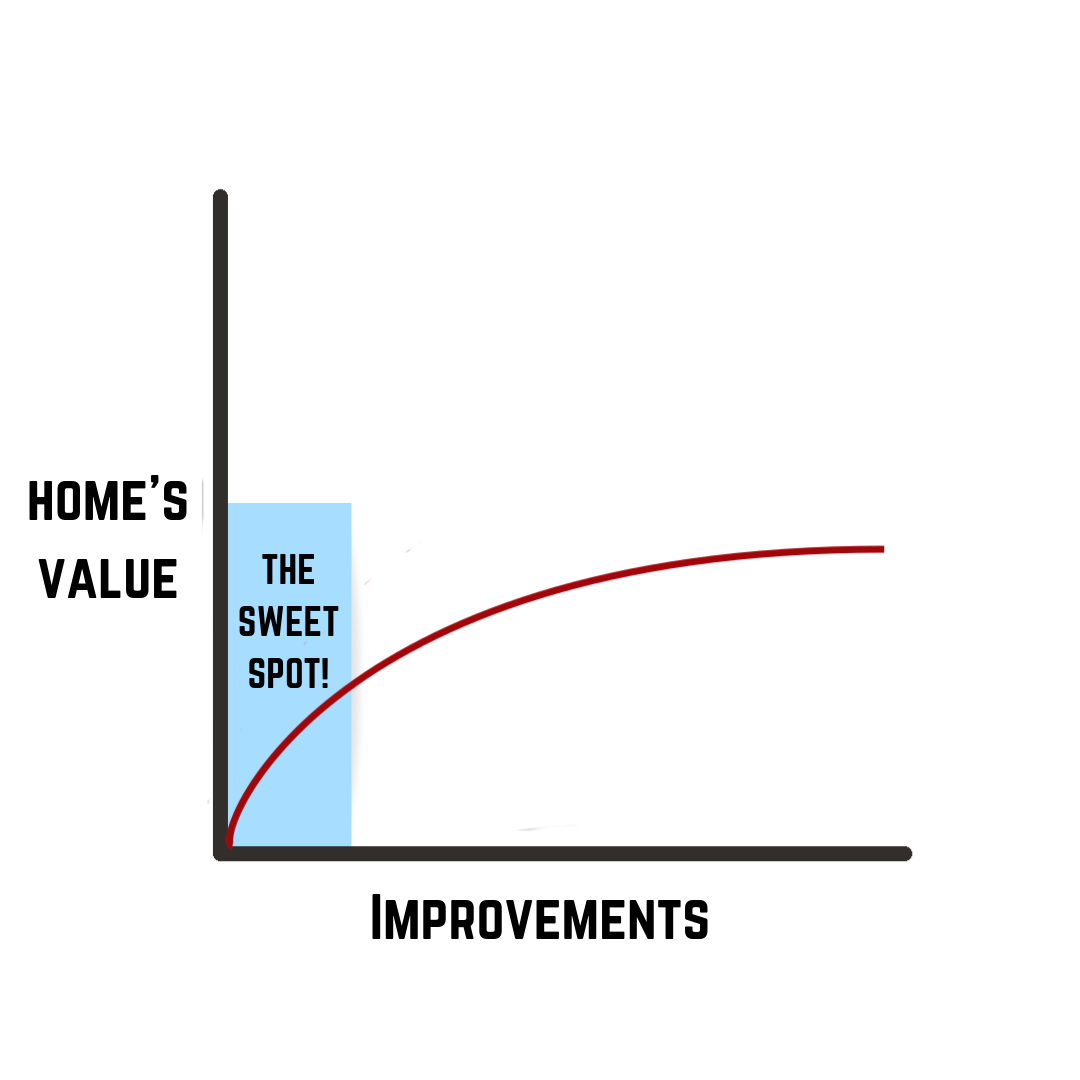 When considering doing repairs to your home to help sell it, my personal philosophy is to take on the mentality of a home flipper. Their mentality is “how can I add the most value for the lowest price?”
When considering doing repairs to your home to help sell it, my personal philosophy is to take on the mentality of a home flipper. Their mentality is “how can I add the most value for the lowest price?”
Think Like a Flipper
Some investors go overboard and just slap a little lipstick on a pig when they remodel a home. I’m not talking about that. I’m talking about the solid home flipper that provides a great product that buyers love and often bid up the price.
Flippers will still do the major home repairs to the structural and mechanical parts of the home if they are in disrepair, but if something is older and still in good condition, they most likely won’t touch it. This is a great rule to live by.
You can see my simple line graph with how the increased improvements to your house adds more value to your home. There is a sweet spot that you can find with your real estate professional depending upon how many updates you have already completed. At some point, adding more improvements provides little to no added value.

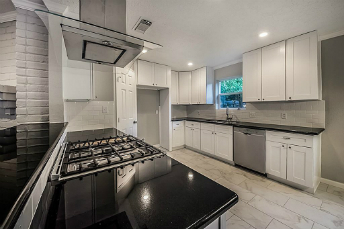
Before flippers do any repairs, they calculate what the top selling price for a home will be and make sure they don’t lose money by over-improving. It is very important that your agent does a great market analysis and provides you a realistic perspective of what your house can sell for after all the work has been completed.
So, let’s first dive into repairs that you should NOT do.
*I’ll be speaking in generalities through the rest of this section (the entire post, actually) talk with your professionals to get their advice as it will vary mostly on what is common for your area.
Updates Not Worth the Investment
- Install new windows – If your home has older single paned windows, then spending the money for double paned windows won’t provide a positive return. Installing $5000 worth of new windows throughout the home will not raise the selling price much. As a homeowner, you will begin to see an overall savings after installing new windows around the seven years mark or so, and therefore it’s a long term investment. If you have to replace some windows, I would recommend replacing just the windows on the first floor or a particular area rather than the entire house.
- New Mechanicals – This includes your air conditioner, heater, plumbing, electrical, water heater and so on. If it’s working, then don’t replace it. If it’s working but it is about to break at any moment and could cause more damage, then by all means replace it. This part of your home is expected to be working and worry free to the buyer. Any problems you have with them will definitely hurt your final sales price but adding a brand new HVAC for $10,000 won’t increase your sales price $10,000. If they ask for concessions or for you to repair it, see if you can negotiate to give them a credit or split the cost.
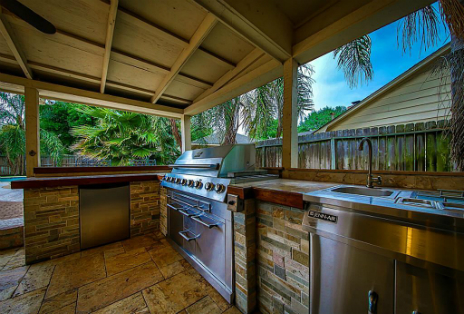
An Outdoor Kitchen May Only Return 20% of the Installation Costs - Pool & Outdoor Kitchen – The value an update gives to a home will ultimately be at the discretion of the home appraiser (unless the buyer is paying cash or they have a non-conforming loan). Unfortunately, appraisers usually only add a few grand for outdoor kitchens. It hurts to see the $5k boost to your value after you spent $20k on your beautiful outdoor five star restaurant quality kitchen. Pools fare little better. A $50k pool will often get a $20k to $25k bump with an appraiser’s valuation. This obviously changes based upon your price point.
- Brand New Roof – This one can fit in with the mechanicals section as to how to treat it but since it’s so visible, it deserves its own section. If your roof isn’t leaking but it’s toward the end of its normal life, then I would recommend negotiating with a buyer to share some of the costs. A new roof can cost around $10k for a normal home and with a good agent, you can probably settle on way less. If the roof is past it’s life and without leaks, then I like to try to negotiate the best possible deal, but I am usually able to get at least a 50/50 split for the roof (5k in savings (hallelujah emoji)). If the roof is leaking or there is an overlay roof (multiple layers of roofing over top one another), then I would recommend replacing it prior to listing as the buyer could have difficulty getting insurance.
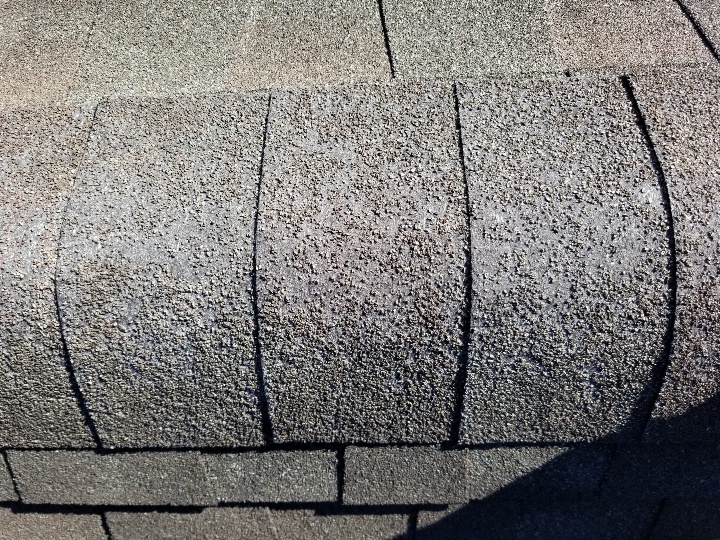
- Expensive Drapes – Drapes become dated very quickly and can keep your home a few decades behind.
- New Driveway – Overtime soil moves and cracks can form in your driveway. I wouldn’t recommend replacing an entire driveway unless it is just in poor shape. Usually repairing one section or a good power wash can have a positive improvement.
Updates that Can Provide a Great Return
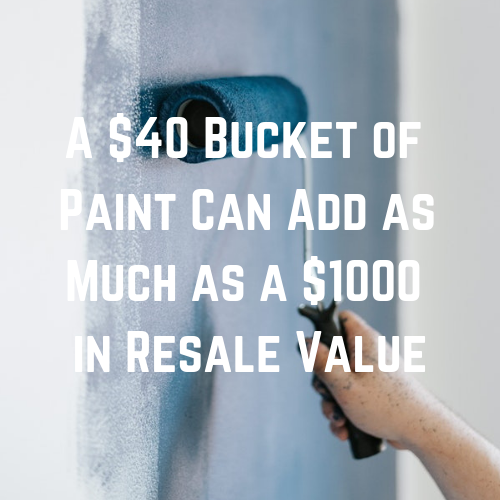
These are less expensive repairs and updates that can provide a great return on your investment:
- Fresh Paint Throughout
- Freshen up the Exterior
- Add Mulch and Fresh Flowers
- Replace All Cabinet Hardware
- Replace All Door Hardware to Match
- New Backsplash
- Add More Lighting and Replace Burnt out Lightbulbs
- New Vanity Lights in Master Bathroom
- Refinish Hardwood Floors
- Caulk where Needed
- Repair Damaged Siding and Rotting Boards
- Power Wash Siding and Sidewalk
- Refinished Front Door
- If the Carpet is in Terrible Shape, Replace it
- New Tile Grout
Often times, it is the accumulation of small, rather inexpensive projects that make the entire house feel new and fresh.
I believe many homeowners miss out on some equity when they sell their home because they don’t do the right updates & repairs. If they do spend money on updates, they don’t do them well or they do work in all the wrong areas.
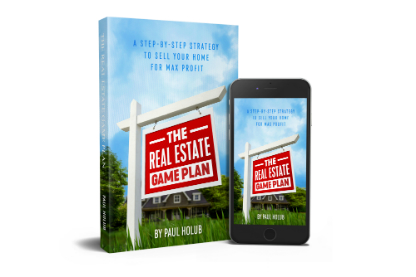 My book, The Real Estate Game Plan, helps to create your own personal game plan to sell your home fast and get the most money. Sign up for a free ebook or contact me to create a personalized game plan for your home (example of a personalized Game Plan).
My book, The Real Estate Game Plan, helps to create your own personal game plan to sell your home fast and get the most money. Sign up for a free ebook or contact me to create a personalized game plan for your home (example of a personalized Game Plan).
Next I will cover what is needed to get your home in perfect condition for buyers.
Contact Paul to Schedule an Appointment to Sell Your House
Step 4: Stage Your Home
I keep talking about staging, but what does it really mean to stage a home? Staging a home is the process of arranging furniture and decoration in the most attractive way possible.
Staging a home does help to sell more quickly. From the National Association of Realtors, “62% of seller’s agents say home staging decreases the time a home spends on the market.”
Think about walking into the model home of a new home builder. The house has trendy and inviting furniture, is always smells amazing and it has incredible finishes. It just makes you want to live there!
 That’s the feeling we want buyers to get when they walk through your home. Keep that as your goal for your home because believe me, if you can create that feeling, you will attract a great buyer. There are a surprising large number of homes on the market that are dingy, need work and have a smelly smell.
That’s the feeling we want buyers to get when they walk through your home. Keep that as your goal for your home because believe me, if you can create that feeling, you will attract a great buyer. There are a surprising large number of homes on the market that are dingy, need work and have a smelly smell.
If your home looks and feels amazing to buyers, then just start packing now because the offers should start rolling in.
But first… a few tips.
Do You Have to Do Everything the Home Stager Suggests?
Your professional stager will tour your home and will suggest a wide range of things to do from moving furniture and décor to major remodeling projects, but you get to decide what is right for you and your budget.
I once toured a home of my good friends when they were meeting with the home stager, just to experience it like a home seller. After a few short pleasantries, we started touring the home and the stager began making suggestion after suggestion and I could just see the faces of my friends change from pleasant to hostile within minutes.
They were polite but they basically completed none of her suggestions because they were so offended that she came in and insulted their decorating style. I do admit she was a little more blunt than most of the staging professionals I work with, but it is her job to be direct and share her opinions about what will help sell the home faster and for more money.
[bctt tweet=”Don’t take it personally if the home stager seems to insult your sense of style, its their job to be direct.” username=”TheHolubTeam”]
So, the answer is no, you don’t have to do all the work they suggest but I would encourage you to be open to more of their suggestions than not.
How to Stage a Home
Home staging is not my gift, so I leave that to the professionals. If you haven’t read it already, check out this great article with the best advice from the top 23 professional stagers in Houston to get an idea of what exactly you need to do to get your home ready.
Should You Stage a Vacant Home?
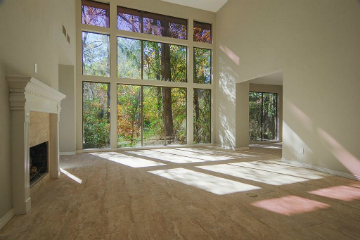
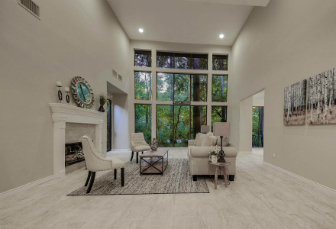
The short answer is YES, and the long answer is yes but only if it works in the budget. To see if it fits your budget, check out this article on how to cost effectively rent furniture for staging your home.
Homes that are occupied sell faster than vacant homes.
The reason this happens is because many people have no imagination as to how a room can be laid out. Giving them an example with your items or with rented furniture will help them see how your house can become their home.
According to NAR’s Profile of Home Staging, Forty-nine percent of buyers’ agents cited that home staging had an effect on most buyer’s view of the home.
Taking time to declutter, depersonalize your home and to jazz it up with some elegant staging will help your home pop and thus sell more quickly. Now we will talk about how to show it off with awesome pictures.
Step 5: Take Professional Real Estate Photography
If your agent takes pictures with their phone for the MLS, fire them on the spot.
[bctt tweet=”If your agent takes pictures with their phone for the MLS, fire them on the spot.” username=”TheHolubTeam”]
No seriously, do it.
According to the National Association of Realtors 2018 Survey of Home Buyers & Sellers 93% of buyers used an online home search website to find their next home and 50% of those found the home they ended up purchased online. The second largest group was their real estate agent at 28%.
Since almost all buyers are online, it makes sense to optimize your home’s online presence. The best way to do that is with amazing pictures.
It’s What Buyers Want
If you have your local MLS app, pull it up on your phone and look at a couple of homes in your price range. Which homes grab your attention first? Right! The ones with the beautiful pictures of course.
The number one thing buyers find helpful when using the internet to find a home are the photos.
So, if that is what buyers want, give them the best photos you can get with a professional HDR photographer.
What You Want in Your Photographer
If your Realtor doesn’t provide a professional HDR photographer, then you need to do some research to find a special photographer. The great thing is that you can compare right over the internet the quality of their photos.
I like to look for a photographer that does HDR (high dynamic range) photography. This is when the camera actually takes thee pictures of the same image at a high, medium and low exposure and compresses them into one picture. It looks phenomenal!
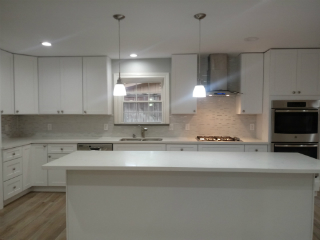
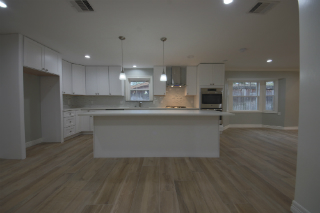
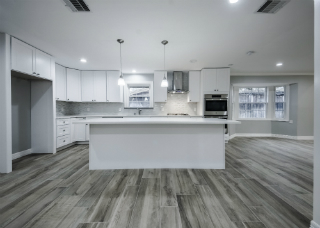
You can see that the picture taken with the phone makes a beautiful kitchen look rather dull. The standard photograph has a wider angle, increased the detail of the image and removed the blur from the light. However, it sill doesn’t quite make the kitchen pop.
The HDR photography looks absolutely amazing. The image is crisp, it’s bright and it does justice to a beautiful kitchen.
How Much Does Good Real Estate Photography Cost?
A great real estate photographer will charge between $150 and $500 depending upon the size of the home and what you are requesting. A twilight shot will be more expensive along with any aerial photography, but each will add a different element to show off your home.
When is the Best Time to Take Real Estate Photography?
I believe the best shots are at twilight, which is right before the sun comes up or right after it goes down. The indirect light makes everything come alive.
To prepare for a twilight photoshoot of your house, turn every light on in the house, open the blinds and the curtains to show your home in its best light. Get your house as clean and tidy as your stager directed and as humanly possible for you and your family.
Make sure to park your cars down the street or in the garage as you are selling your house, not your car. And for heaven’s sake, turn off the T.V. for 10 seconds while the photographer is taking the pictures.
Examples of Twilight Shots
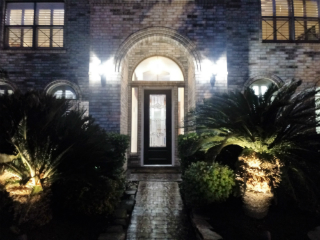
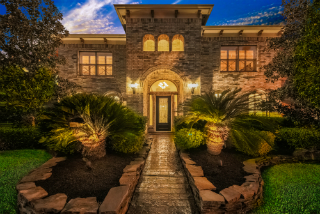
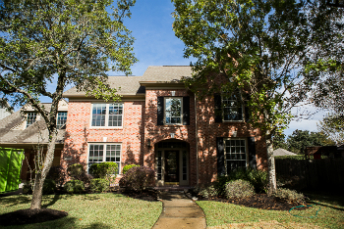

And because I’m all about full disclosure, check out the facebook page of my top Houston Real Estate photographer who provides amazing HDR photography for a great price, and in only 24 hours.
A Word of Warning
Because photoshop and HDR photography are amazing, it can look way better than the actual condition of your house.
We once had a listing that needed a major remodel because it was basically untouched since the 1970’s. Oh, and it needed foundation work, too. My photographer took his twilight shots, photoshopped in a beautiful sky, and did a little touch up on the photos and just made the home look beautiful.
As it was, the home really wasn’t livable in its current condition, so many buyers were frustrated to walk in and find a home completely different than the pictures displayed. It wasn’t our intention to mislead the buyers so we replaced some of the pictures to provide a more accurate portrayal of the home.

The home should be advertised in it’s best light (just like you are in your dating profile picture) but it should not be so ‘doctored’ that people come away angry that the photos misrepresented the home (just like Realtor® glamour shots). 😊
Wrap Up
Your house now looks and smells amazing, pretty much like a model home. You have taken great pictures because great pictures can make the difference between a buyer deciding to schedule a tour or not, and the more tours, the better your chances are of getting an offer (or multiple offers). Next, I’ll talk about how to make your home can blow the competition out of the water.
Step 6: Make Your Home Stand Out on the Market
At this point you are very close to being able to list your home on the market and get is sold quickly, but first you need to analyze your competition and see what you can do to help you home stand out even more.
Real Estate is a Competition
 In case I haven’t already made it clear, it’s a competition and you are competing for the buyers vote (well, money actually). When selling a home, you can compete on three general categories: price, condition and location.
In case I haven’t already made it clear, it’s a competition and you are competing for the buyers vote (well, money actually). When selling a home, you can compete on three general categories: price, condition and location.
You can only control over two of those categories: your price and the condition. If the level of upgrades for your home is top shelf, then your price will get a boost over the competition. Similarly, if your home has no updates and needs a ton of repairs, the price will drop accordingly.
Its not rocket science but more homes sit around on the market because homeowners don’t understand this simple principle. Or they do understand it and yet they think their home is nicer than it really is.
Remember When You Bought Your House?
We will get more into price in the next section (step 7) but I want to take you back to when you first purchased your home. I want you to remember why you chose your house over all the other homes on the market.
I’ll wait…
Awesome! The reason you fell in love with your home will most likely be the same reason the new buyers fall in love with it.
[bctt tweet=”The reason you fell in love with your home will most likely be the same reason the new buyers fall in love with it.” username=”TheHolubTeam”]
For example, one of my clients bought their home because they loved the backyard. The backyard had a new patio cover, an outdoor water feature and appealing landscaping.
Wouldn’t you know, the buyer that bought the house ended up falling in love with the home. What was the number one factor in their decision? It was the backyard.
So, let your agent know why you decided to buy your current home and what you love most about it (unless it’s a lame story like “there were no other homes left.”) 😊
It will likely help attract the right buyer.
What Makes Your Home Unique?
If all the homes in your neighborhood are in about the same condition, buyers will have a difficult time picking yours over the competition. To sell more quickly, figure out what you have different from your competition.
 Maybe you closed off a room to create a private study or added chalk learning wall or installed a wine refrigerator because you love having a glass of wine on the patio and watching the sunset. Buyers not only want a move-in-ready home, they want the lifestyle your home can provide. Sell them on the great lifestyle you enjoy, and buyers will be attracted to it.
Maybe you closed off a room to create a private study or added chalk learning wall or installed a wine refrigerator because you love having a glass of wine on the patio and watching the sunset. Buyers not only want a move-in-ready home, they want the lifestyle your home can provide. Sell them on the great lifestyle you enjoy, and buyers will be attracted to it.
Take time to tour some of your competition in the neighborhood. Put on your buyer’s hat and experience the house as a buyer would. Is it in better condition or a better price than your home? Is it a better value?
Buyers won’t be fooled, they know when a home is a great value. Think about how your house can win the hearts and minds of the buyers looking in the area and you will stand out for the better. Next, I will talk about the most important step to selling your home fast.
Next I will cover what is needed to get your home in perfect condition for buyers.
Contact Paul to Schedule an Appointment to Sell Your House
Step 7: Price Your Home to Sell
I believe that any home on the market can sell, and that it is just a factor of price, condition and location (marketing is the 4th “X” factor).
There are a few strategies I utilize when pricing a home that I review extensively in the book (chapter 7), but I just want to give you some actionable information here.
#1 Mistake Home Sellers Make
The top mistake homeowners make when pricing their home is listing it too high.
[bctt tweet=”You are most likely to get your highest offer price within 21 days of listing your home for sale.” username=”TheHolubTeam”]
I once met a seller who had his house on the market for over two years! He had been through a couple of Realtors® and yet it had not sold. The home was a great size, it was dated from the 90’s, but all-in-all, in good shape.
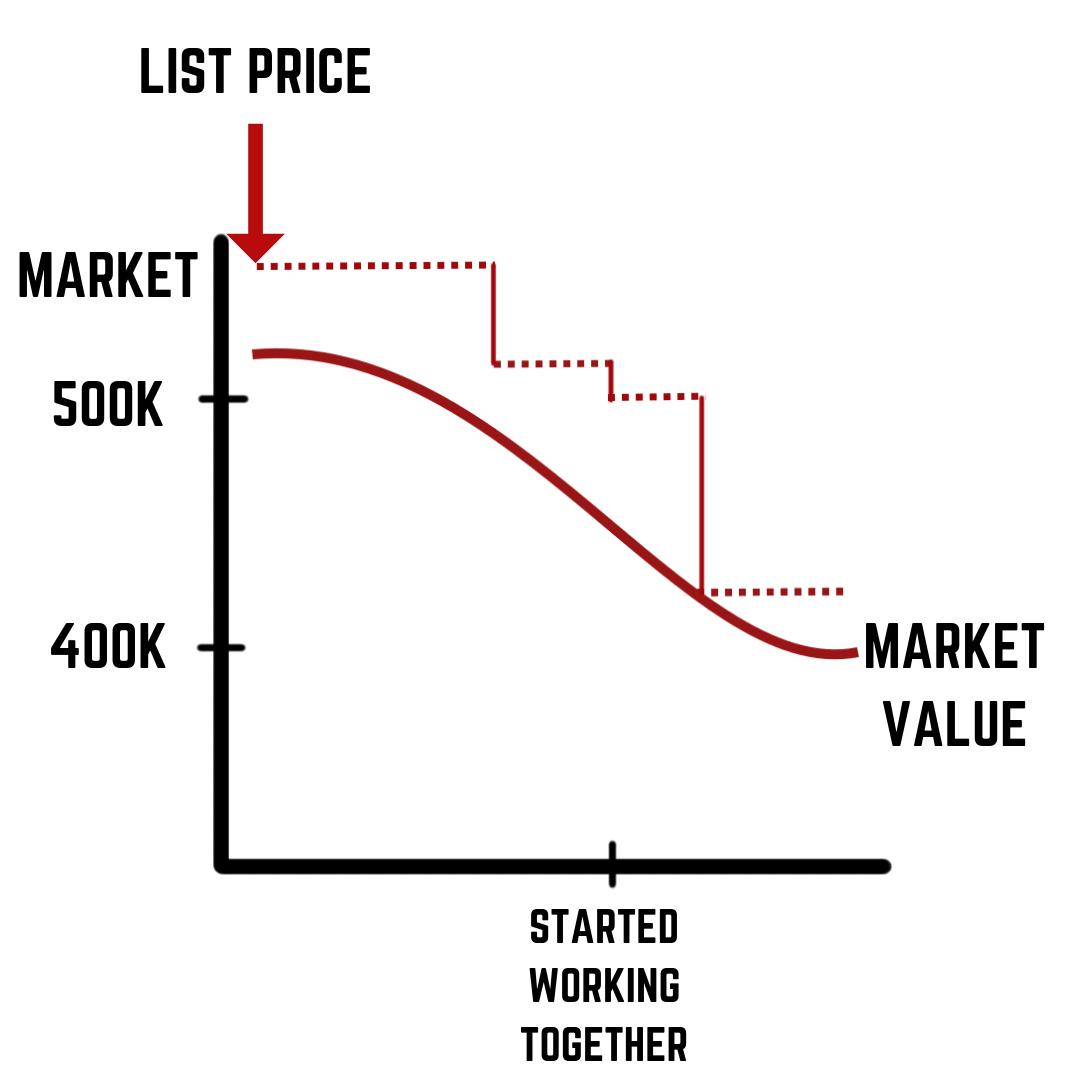 He told me that during the first time he listed the home, he had an offer in the first 30 days. It was close to his listing price in the $500’s, but he declined it expecting a better one to come along. Unfortunately, the market started to trend downward, and his listing price never caught up to the market.
He told me that during the first time he listed the home, he had an offer in the first 30 days. It was close to his listing price in the $500’s, but he declined it expecting a better one to come along. Unfortunately, the market started to trend downward, and his listing price never caught up to the market.
When we began working together, the seller made a few changes to the property, but he still wanted to list his home in the upper $400’s. We tried for a few months and had an increase in tours, but still no offers.
I finally convinced him to list it closer to where I thought the market value was, and within two weeks we had two offers around my estimated market value. Had the owner accepted the first offer he would have taken home $100,000 more.
I have story after story with homeowners over-pricing their home initially and eventually having to sell for much less than if they would have priced it correctly to begin with.
Know The Market
Your real estate agent will give you an idea of where the market is heading. In an upward trending market, you might be able to get away with a little higher starting price. In a slow or downward trending market, it is vital to price your home at the market price.
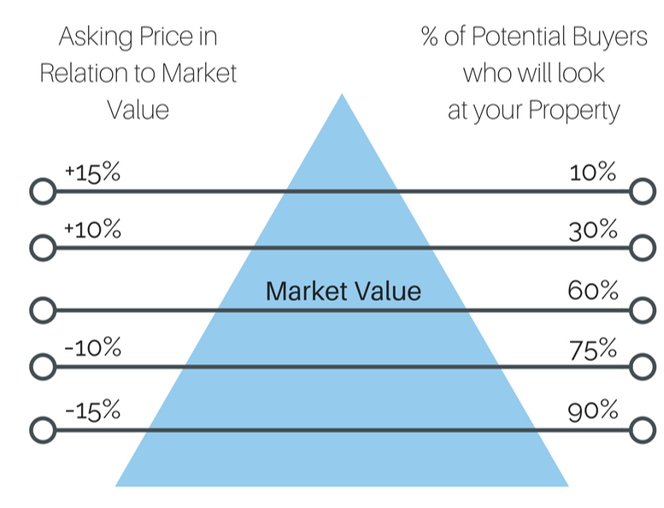 Check out the pricing pyramid (triangle actually, but pyramid sounds cooler). The “pyramid” represents the percentage of buyers that could consider your home as an option. If you price your home at market value, you have between 30% to 60% of buyers that may tour and consider an offer because of the value.
Check out the pricing pyramid (triangle actually, but pyramid sounds cooler). The “pyramid” represents the percentage of buyers that could consider your home as an option. If you price your home at market value, you have between 30% to 60% of buyers that may tour and consider an offer because of the value.
As you go higher in price, your pool of potential buyers dwindles to a much smaller percentage.
The lower you drop the price the greater number of buyers will consider making an offer and you could find yourself with a multiple offer situation.
Some properties already have a small pool of buyers due to a remote location, strange layout or just being an “odd ball” listing in the neighborhood. This makes pricing all the more important and relying on your professional agent’s advice.
Best Time to Sell?
People ask me all the time, “when is the best time to sell a home?” My answer is “whenever you need to move.”
Even in the slow home selling months, Houston we will sell over 4,000 single family homes. The Number of Single Family Homes Sold graph shows the homes that were sold in 2017 & 2018. There was a dramatic drop in August of 2017 due to Hurricane Harvey but you can see the trend of more homes selling in the summer season.
Peak summer months will sell up to 8,500 homes, so naturally it makes sense to list the home in the spring and summer, right?
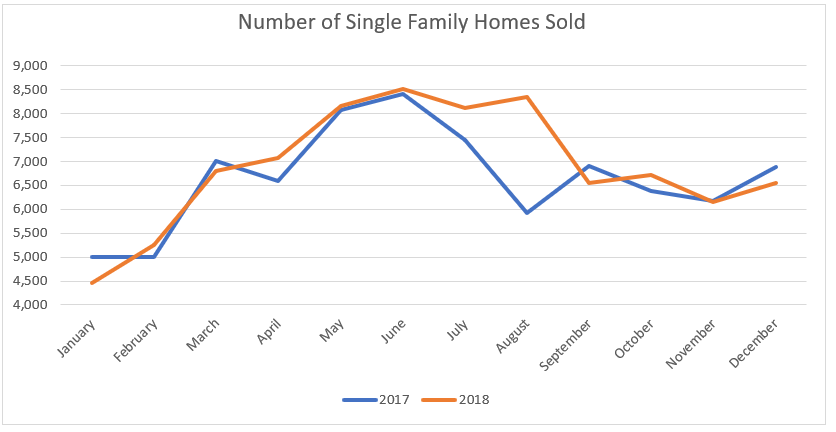 Obviously, there is a season in which more people are buying and selling homes and thus a greater likelihood of selling quickly. So, if you can, I recommend listing in the spring to early summer if that works well for you and your family, but a great home can sell quickly during peak months as well as the slower months.
Obviously, there is a season in which more people are buying and selling homes and thus a greater likelihood of selling quickly. So, if you can, I recommend listing in the spring to early summer if that works well for you and your family, but a great home can sell quickly during peak months as well as the slower months.
From September to December, Houston sold between 6,000 and 7,000 homes. That’s a lot of buyers moving and it only takes one to fall in love with your house.
Before listing your home, it is a good idea to take a look at the current home inventory. Home inventory is the number of active homes on the market. January of 2018 had just over 33,000 single family homes for sale, whereas last June & July saw around 43,000 active homes. There may have been more buyers during the summer months, but there were 10,000 more options for them to choose from.
When you put your home on the market is important, but it is just one piece to the puzzle. Pricing your home correctly is the top thing you can do to get your home sold fast and for the most money. Next, let’s talk about what to do when your home is on the market.
Step 8: Make Your Home Available to Buyers
The entire purpose of our work is to attract the right buyer to tour your home. It does you no good if they can’t schedule a convenient time to see it.
Make sure you work with the buyer’s agents to allow tours of your home. No one will buy a home they are not able to tour unless its for a steep, steep discount.
How Showing Your Home Works
Sometimes your agent will receive a request from a buyer asking to see your house, but typically the buyer’s agent will request a tour and show their buyers around your home.
When a buyer wants to see your home, they will ask their Realtor® to schedule a showing. We work with a service (Centralized Showing Service) that coordinates with the agents and sellers like yourself, to make the scheduling process as smooth as possible.
Let’s say for example that the buyer wants to tour tomorrow at 4:30, they will place the request online and you can accept, deny or ask for them to reschedule at 5:15 or whenever works for you.
The company will email and call the agent to work out the new time. If they accept, then you as a homeowner need to be away from the home for the duration of the tour. It usually is set up for an hour, but I will often make the showing window smaller to limit your time away.
Blocks and Restrictions on Home Tours
A great way to keep your sanity during the process of selling your home is to put blocks and restrictions on when buyers can tour your home. I always suggest at least a two-hour notice of a showing be provided to you when a buyer wants to see your home. This way, you have some time to prepare your home for the tour and to determine where you will be for the duration of the showing.
The two-hour restriction can be changed to four, six, eight, twelve hours or more.
[bctt tweet=”Allowing buyers to tour your home is a balance between making the home as available as possible, and not losing your mind from always having to leave your house in an instant.” username=”TheHolubTeam”]
This is a similar balance when it comes to showing blocks. Showing blocks are times in which buyers are not able to tour because they are permanently blocked off the schedule. I recommend this when home sellers have a crazy night on one particular day of the week, every week.
Lilly goes to volleyball practice Tuesday evening, Mom has workout, Dad takes John to basketball then picks up Lilly and John and takes them both to club swimming practice. It is hard enough to figure out what to eat for dinner much less have the home “show ready.”
Block off that one evening every week to keep your sanity.
Showing Your Home with Kids & Pets
 Allowing buyers to tour can be a hassle, no doubt, especially when the buyers and their agent come late or not at all, and you just spent the afternoon cleaning up. To help make the process of getting ready for a home tour easier, especially when working with pets and kids, I have a few recommendations:
Allowing buyers to tour can be a hassle, no doubt, especially when the buyers and their agent come late or not at all, and you just spent the afternoon cleaning up. To help make the process of getting ready for a home tour easier, especially when working with pets and kids, I have a few recommendations:
- Keep the Showing Window Short – Allowing a maximum of a 30 to 45 minute showing window when the average is an hour, makes the buyers have to focus on your home and to be there on time. This is especially true when they are seeing multiple homes one right after another.
- Wait Until the Last Minute – With the shorter showing window you can wait until the buyers and their agent arrive at your house and hustle the kids and the pets into the car or take them on a walk to the park.
- Give Every Family Member a Job Responsibility – To help keep the house clean, divide and conquer the cleaning tasks so that you are not the only one getting the home ready. If you have kids that are older, you can provide them with a list of jobs they need to do prior to leaving for school that day or even the night before. Teach them what it looks like for it to be clean and up to showing standards, and when it’s not clean enough. Make it a competition by giving points to the family members that kept their area clean or make it a group effort in which everyone gets a big reward once an offer is accepted.
- Storage Bins are Your Friend – Your home should already be decluttered, and the excess items removed, so try to keep just the basics of what you and your family need. Instead of a million toys, keep it to a storage bin or two for each kid. After playing with it, they know that it all goes back in the bin and gets stored away for showings.
- Stack Showings – Sometimes it is just impossible to have a home always ready to go with just a 2 hour notice, so it can be beneficial for some people to have set times during the week for tours: Tuesday 3-7 pm, Thursdays all day, Friday 4:00 – 7:30 pm, and Saturday 10-4 pm. With a schedule like this, you know the times buyers could request a tour and you will be better prepared.
Safety Tips When Selling Your Home
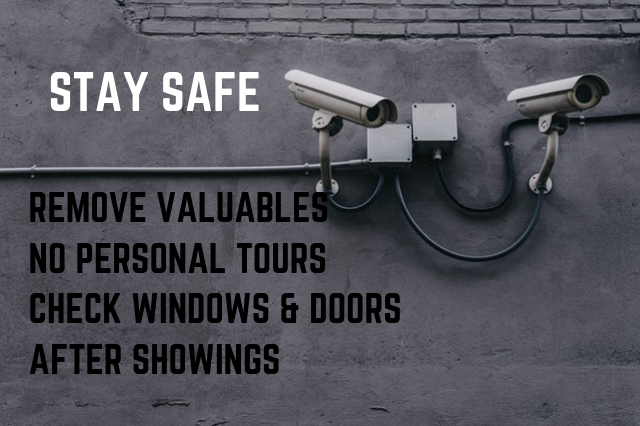 Unfortunately, not every person walking through your home has the best of intentions. To protect your family and your belongings, here are a few tips:
Unfortunately, not every person walking through your home has the best of intentions. To protect your family and your belongings, here are a few tips:
- Never Personally Give a Buyer a Tour – If a buyer knocks on your door, don’t give them a tour. Call your agent and have them schedule a tour with them. I won’t scare you with any stories we hear in the industry so just don’t do it.
- Remove Valuables – Prescription pills, jewelry, cash, priceless paintings and collectibles, firearms and so forth need to be removed from your home or locked away in a safe.
- Check Windows and Doors – If you are able, after each tour do a quick walk around your first floor to make sure all the windows are locked properly, and the doors have not been tampered with. If anything is missing or is out of place, call your agent immediately.
I use an electronic lockbox so I have record of anyone who accesses the lockbox. If something were to happen to the home, we can go back and review the records.
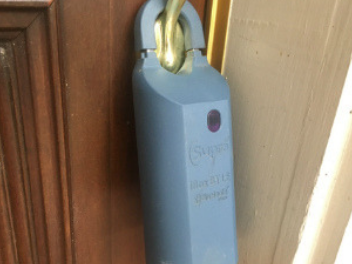 The buyer’s agent is responsible for having the buyers stay together and keeping an eye on them. So, there are various levels of protection but keeping valuables out of plain sight is the best strategy.
The buyer’s agent is responsible for having the buyers stay together and keeping an eye on them. So, there are various levels of protection but keeping valuables out of plain sight is the best strategy.
Allowing your home to be as available as possible for home tours is crucial to selling your house quickly. If you are occupying the house, you need to find a balance of making it available and still keeping a normal family life. Always keep safety in mind.
In the next step, I’ll cover what it takes to market your home to generate even more interest from great buyers.
Step 9: Market Like Crazy
My job as a real estate agent is to market your home like crazy to get buyers in for tours. Your job as the homeowner is to get the home in its best condition and price it well so that it will sell. It is a relationship that both sides need to pull their weight.

The number one marketing tool we have as real estate professionals is the multiple listing service (MLS). This is where your home is syndicated out to hundreds of different websites where buyers are looking for homes to purchase. With over 93% of buyers using the internet to find their next home, this becomes critical for maximizing the exposure of your home.
Not only do you get more exposure, but buyers who are looking on the MLS tend to pay the most for homes. Let me explain.
Think about a homeowner who tries to sell a home on their own. As an American, we have the wonderful ability to do with our own property as we please and being able to sell it yourself is an option. A homeowner can put their home on a few websites for sale, but they won’t get the hundreds of websites available.
Also, buyers that look for homes being sold by owner are usually looking for a deal or they frequently have problems with getting a loan. So, they don’t attract buyers who are willing to pay top dollar and they don’t get as much exposure.
Top 5 Home Marketing Tactics
In addition to the MLS, here are my top 5 marketing tactics to get you even more traffic:
- Pretty Homes Sell Themselves – Do the work to get the home ready: staging, professional HDR pictures, and allow home tours. Having a great product is the best way to sell quickly.
- Maximize Your Detailed Description – Some buyers have set up their online searches with very specific parameters, so it is best to make sure your agent fills in all the applicable fields in your MLS. Some fringe buyers are looking for something very specific in their new home, which could include a media room, mother-in-law suite, workshop or other features and adding that info will help your home show up in their search. Also, the copy for your listing is very important, so don’t skip out on it.
- Create a Mega Open House – Open houses have lost some of their effectiveness. In 2003, 16% of buyers said they found their home through a yard sign or an open house. In 2017, that number dropped to 7%. While it isn’t as effective for getting a buyer to seal the deal, it can be effective for creating urgency. If an interested buyer walks in and sees other buyers talking positively about the house, it reinforces their feelings and helps them justify their purchase.
- Social Media – Don’t neglect to share your listing on your social media platforms. More often than not, a friend or family member wants to move into a neighborhood and a quick message can activate a dormant buyer. Also, it can be effective marketing for an open house.
- Other Agents – The old broker only open house is dead, but marketing to other agents who live and sell in the area is a great idea. They often have buyers or dormant buyers looking in the area, so talk with your agent about marketing to them.

Doing these extra marketing tactics will help to increase traffic to your house. You and your agent’s job is to get as much traffic through your house to generate lots of interest that leads to quick offers.
With all your traffic, one of the best things you can do is monitor the feedback of every interested buyer. If you constantly receive feedback like the carpet is in bad shape, then you can replace it or place a sign in the room letting the buyer know you are open to providing a credit so they can pick the flooring of their choice.
Unfortunately, we found that less than 40% of agents provide feedback after a tour. It is incredibly frustrating after you made your home available and they won’t even take two minutes to provide a quick response.
We make it a point to call, email and text each agent multiple times until they respond. We see a response rate 70% or higher and it helps tremendously when feeling out the market for a home.
Another simple thing we do that is uncommon is that we provide a weekly update on how the sale of your house is going. We send out an email or call (usually on Tuesdays) each homeowner selling their property with the marketing activities, a feedback report on all the tours and what kind of online traffic their website is receiving.
It is a simple thing, but hardly any agents do it and it just helps keep everyone up to date and responsive to the market.
I dive deeper into marketing in The Real Estate Game Plan if you’d like some outside the box ideas on marketing. To get the biggest bang for the buck, I focus on where the majority of buyers are looking and work to maximize exposure through those channels.
Correctly marketing your home can have a huge impact with reaching the right buyers. Make sure your professional real estate agent is communicating with you their marketing efforts and providing current feedback. For the final step, I’ll review what to do once you receive an offer.
Step 10: Negotiate & Accept the Best Offer
You have an offer, now what? Well, negotiate of course!
First Step to Negotiating in Real Estate
Review the contract fully so that you know the terms. Be sure to discuss with your agent the major requirements for you and what contingencies you are allowing the buyer to have.
In Texas, the 1-4 Family Residential Contract otherwise known as the contract, it is very slanted toward the buyer. Once an offer is accepted and valid, it can be difficult for a seller to back out. However, the buyer often times has multiple contingencies to get out of the contract: option period (the inspection time frame), credit approval, appraisal contingency, HOA contingency and so forth.
You need to know the major deadlines in the real estate contract and up until which dates your buyer can back out.
We provide a document with all the major contract deadlines to our clients and you can get a free copy of that here.
Know Your Buyer (and Their Agent)
 There are usually four different people in a real estate transaction (buyer, buyer’s agent, seller and seller’s agent) and everyone has a little different negotiating style. This can obviously make things tough especially when the negotiations get heated.
There are usually four different people in a real estate transaction (buyer, buyer’s agent, seller and seller’s agent) and everyone has a little different negotiating style. This can obviously make things tough especially when the negotiations get heated.
Get as much info about the buyer and the agent as you can. Know why the buyer is moving, where they are coming from, if they are in a hurry and any other info you can gather will give you a better picture of what is important to them and if you can find any leverage.
A home buyer that is relocating for work and has one weekend to find a home is going to negotiate differently than the retired couple looking for a new home to retire to.
Have your Realtor® gather as much info from them as possible and be aware that you can have a ready and willing buyer, but the buyer’s agent (or your agent) can get their ego in the middle of the negotiations and ruin the deal.
If you want a great resource on negotiating, check out the book, Never Split the Difference by Chris Voss. It is absolutely amazing! Chris is a former hostage negotiator and really gives you practical advice for getting the best deal possible. This is my favorite negotiating book by far.
Know the Market
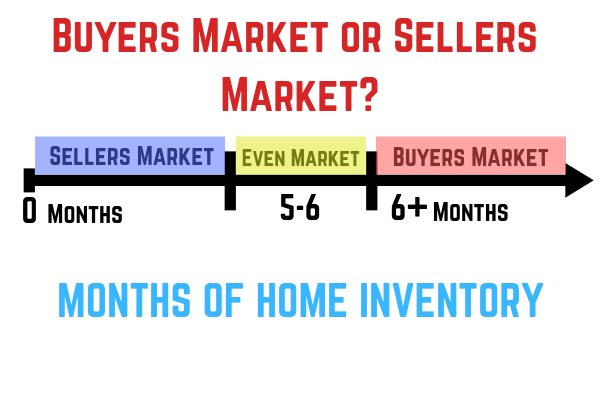 Real estate will cycle from a seller’s market, to an even market, to a buyers’ market and so on and so on. In a seller’s market, you will often have the upper hand in negotiating as there will likely be other interested buyers. The reverse is true for a buyer’s market with ample home inventory.
Real estate will cycle from a seller’s market, to an even market, to a buyers’ market and so on and so on. In a seller’s market, you will often have the upper hand in negotiating as there will likely be other interested buyers. The reverse is true for a buyer’s market with ample home inventory.
Clients of mine had a beautiful home we listed in a seller’s market but unfortunately, their little neighborhood had tons of listings and nothing was moving. Within a few weeks, we had a decent offer but from the beginning were very tense. I’m talking “losing sleep” tense.
I had the precarious job of negotiating the best deal for my clients with a buyer that wanted pretty much everything on the inspection report fixed or they said they would just go buy one of the many other similar homes.
I knew that we probably wouldn’t have another offer for an extended time, so they had good leverage on us. Luckily, after a week of quotes and stressful negotiations, we were able to negotiate for the sellers to fix only a few items and they moved forward.
Negotiate: Sometimes its How You Say Something
The national average for the sales price compared to the listing price has historically been around 97%. This means homeowners normally accept a price 3% lower than their starting price. This doesn’t mean you can list your home at 103% of market value in hopes of agreeing to your original 100% goal.
One seller told me that his listing price was non-negotiable and that he didn’t play those “games” that most buyers play. After multiple lower offers and a few months on the market, he changed his tune and we were able to negotiate a contract with only a slight drop in price.
Another thing I find important in negotiations is how you and your agent respond to offers is just as important to what you say. One client of mine was presented an offer that was low, very low actually, but they sent a list of repairs that needed to be made to the house to justify their offer. It offended the seller so much that she wouldn’t talk with the buyer afterward.
Beware of the Lender
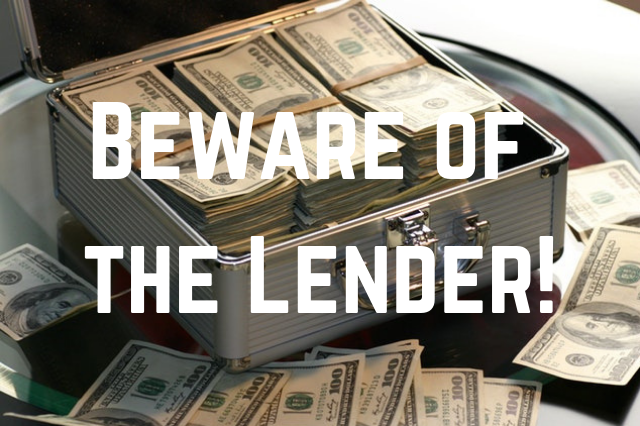 We have a form promulgated form in Texas called the Third Party Finance Addendum. It is another form that provides contingencies for the buyer to escape out of the contract. It basically says that if they can’t get credit approval by a specific time frame, then they are able to back out and receive their earnest money back (Earnest Money is held at the title company to show a seller that the buyer earnestly wants to buy their house. It is usually 1-2% of the purchase price but it is negotiable).
We have a form promulgated form in Texas called the Third Party Finance Addendum. It is another form that provides contingencies for the buyer to escape out of the contract. It basically says that if they can’t get credit approval by a specific time frame, then they are able to back out and receive their earnest money back (Earnest Money is held at the title company to show a seller that the buyer earnestly wants to buy their house. It is usually 1-2% of the purchase price but it is negotiable).
It is aptly named Third Party because the lender is are very much apart of the contract and yet no one really has control over them, not even the buyer. If the bank or your lender needs another week to close the loan, you pretty much have to work with them or start all over with a new lender.
I don’t want to scare you as most lenders I have worked with do a wonderful job of servicing their clients and closing the loan on time. There is a small portion that are flat out terrible and will ruin your home selling experience.
Negotiate with your buyer to create a contract in which their contingencies are limited. Talk with your real estate professional about their experience with the particular bank or lender the buyer has selected as it can dramatically affect your home selling experience.
Bonus Step: How to Buy and Sell a Home at the Same Time (with 5 scenarios)
Wrap up
Selling a home doesn’t have to be difficult. It can be a lot of work but if you follow the 10 Steps to Selling a Home Fast (and get the most money for it), then you will be ahead of most of your competition and well on your way to a fast sale.
The biggest two keys to getting a home sold quickly is 1) working with the right professionals and 2) doing the right prep work when getting the home ready for market.
Good luck on a fast sale!
-Paul
Contact Paul to Schedule an Appointment to Sell Your House

